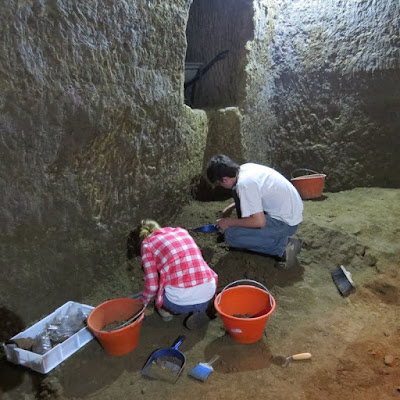Excavation on the west wall of the hypogeum near the Etruscan tunnel that connects this pyramidal hypogeum (Room A) with an adjacent one (Room B). Courtesy Daniel George, Jr.
Archaeologists
are scratching their heads about an underground pyramid-shaped
structure they have been excavating beneath the historic medieval town
of Orvieto in Italy. But it may not be a mystery forever. They hope to
find answers as they continue to tease artifacts and architectural
materials from the soil.
"We
discovered it three summers ago and still have no idea what it is,"
write Prof. David B. George of St. Anselm College and co-director
Claudio Bizzarri of PAAO and colleagues about the site. "We do know what
it is not. It is not a quarry; it’s walls are too well dressed. It is
not a well or cistern; its walls have no evidence of hydraulic
treatments."*
Calling
it the "cavitá" ('hole' or 'hollow' in Italian), or hypogeum, the
archaeologists have thus far excavated about 15 meters down. They marked
their third year at the site in 2014. By then they had uncovered
significant amounts of what they classify as Gray and Black bucchero, commonware, and Red and Black Figure pottery remains. They have dated deposits to the middle to the end of the 6th century BCE.
"We
know that the site was sealed toward the end of the 5th century BCE,"
George, et al. continue. "It appears to have been a single event. Of
great significance is the number of Etruscan language inscriptions that
we have recovered – over a hundred and fifty. We are also finding an
interesting array of architectural/decorative terra cotta."*
READ MORE

No comments:
Post a Comment